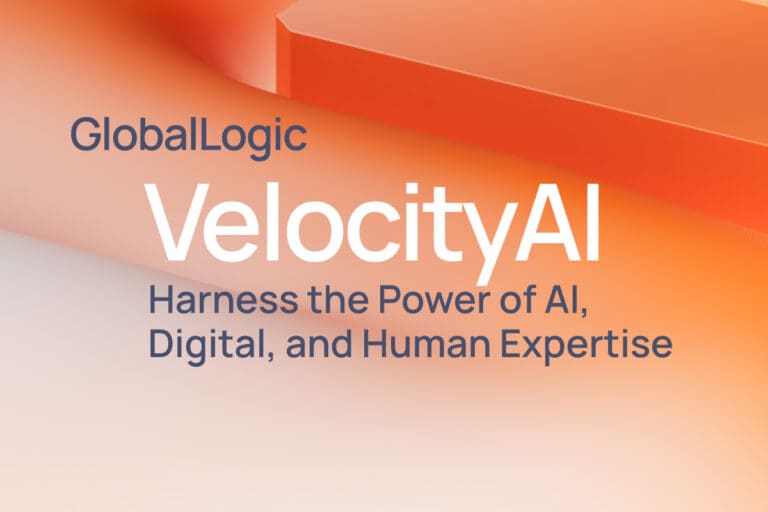- Services
Technology Capabilities
Technology Capabilities- Product Strategy & Experience DesignDefine software-driven value chains, create purposeful interactions, and develop new segments and offerings.
- Digital Business TransformationAdvance your digital transformation journey.
- Intelligence EngineeringLeverage data and AI to transform products, operations, and outcomes.
- Software Product EngineeringCreate high-value products faster with AI-powered and human-driven engineering.
- Technology ModernizationTackle technology modernization with approaches that reduce risk and maximize impact.
- Embedded Engineering & IT/OT TransformationDevelop embedded software and hardware. Build IoT and IT/OT solutions.
- Industries
- GlobalLogic VelocityAI
- Insights
BlogsDecember 16, 2024Gene LeybzonAccelerating Digital Transformation with Structured AI Outputs
This code produces the following output that can be imported into the candidate trackin...
 BlogsOctober 30, 2024Yuriy Yuzifovich
BlogsOctober 30, 2024Yuriy YuzifovichAccelerating Enterprise Value with AI
Discover how financial services integrations are transforming from standalone offerings...

- About Us
Press ReleaseGlobalLogicMarch 11, 2025GlobalLogic Launches VelocityAI to Harness the Power of AI, ...
VelocityAI combines advanced AI technologies with human expertise, helping businesses r...
 Press ReleaseGlobalLogicJanuary 10, 2025
Press ReleaseGlobalLogicJanuary 10, 2025GlobalLogic Announces Leadership Change: Srini Shankar Appointed ...
SANTA CLARA, Calif.–January 10, 2025– GlobalLogic Inc., a Hitachi Group Com...

- Careers
Published on August 19, 2024GenAI and my family reunion
View all articles Dr. Jim WalshCTOShareRelated Content
Dr. Jim WalshCTOShareRelated Content Yuriy Yuzifovich4 March 2025
Yuriy Yuzifovich4 March 2025 GlobalLogic26 February 2025View All Insights
GlobalLogic26 February 2025View All Insights GlobalLogic20 February 2025
GlobalLogic20 February 2025Let's start engineering impact together
GlobalLogic provides unique experience and expertise at the intersection of data, design, and engineering.
Get in touchAI GovernanceMLOpsIndustrial and EnergyAt business meetings over the last year or so, I have a little bet with myself about how long it will take, regardless of the planned agenda, before GenAI is mentioned. Generally it doesn’t take very long. I think that, lately, the record for the longest time before a first mention at work was about 10 minutes. Given that we’re in the software industry I guess that’s not all that surprising. But I got some validation about how widely transformational GenAI technology is becoming at an unexpected place—my recent family reunion.We have a custom in my immediate family of all getting together for a long weekend in the summer. We gather at holidays too, but in the last 10+ years this summer get-together is something we’ve all come to look forward to. We usually meet, as we did this year, mid-July.
I wasn’t thinking of my workplace “GenAI game” at our family gathering. However, even though only one of our four children is an engineer, it still only took about 2 hours! The first mention came from our oldest daughter, who works in medical marketing in Silicon Valley. She told us how she feeds information and points-of-view to ChatGPT and Gemini, and then challenges each of them to come up with copy addressed to different stakeholders and buyers. She gives pointed feedback to the AI on each iteration as it’s generated, and then has the two LLMs face off with each other, to critique and improve each other’s work. Finally, she manually reworks the best version that the LLMs produce. In other words, she uses GenAI as a sounding board and a talented assistant.
Key to success here is her experience as a mid-career marketing executive. She’s encountered some more junior people who think that GenAI can do it all—and we both agree that someday that might be true. But today, her prior experience doing this “the hard way”—with human-produced messaging, written by herself and by teams under her leadership—is what keeps the quality high. Unchallenged, the output of GenAI is not always that good. We’ve probably all experienced that first-hand reading marketing copy that’s obviously been generated based on minimal information, finding it repetitious and largely content-free. But as a tool in the hands of an experienced person, GenAI is a powerful force multiplier—for marketing as well as for software.
Our next-oldest daughter is a teacher working with high school students (ages 14-18, grades 9-12). She has somewhat the opposite problem: Her youngest students don’t yet have the thinking and organizational skills needed to critically evaluate the content produced by GenAI. In fact, those thinking skills are what she’s trying to teach. When denied access to technology, and forced to use pen and paper, she says it’s clear that some of the 9th graders don’t have the basics of organizing an essay or even a paragraph. With GenAI available to do their homework for them—and some use it even when they are admonished not to—her fear is that these students may never gain the necessary thinking or writing skills. How is it possible to determine what her students actually know, and are able to do, when some or all of their output has been generated by a machine?
I think this is a great question. In my own field, of software development, I think it’s very likely that future generations of developers will not know how to code, in the sense that we code today. They will work at a much higher level of abstraction—perhaps at what we now call the “prompt” level, or perhaps graphically or verbally, to describe the desired behavior to a machine. But based on past trends, I’m very confident that the engineers of the future will still have to know how to think analytically and how to solve problems, even when much of the manual effort that software creation requires today is eventually done by a machine. Future engineers will still require critical thinking skills.
Will future generations still need to write, and coherently organize their thoughts? Or will that human function also be replaced by GenAI?
Personally, I’m convinced that even in a future age of strong AI’s (which is still to come), humans will still need to think critically—and probably to a higher degree than we do today. Even if it’s ‘only’ to judge or guide the output of a machine, the ability to think coherently and to express ourselves succinctly does not seem to me like a skill that humanity can afford to give up. In fact, I think human creativity coupled with machine productivity will lead to greater works in all fields than we’ve seen before: literature, science, art, music, philosophy and, yes, software. Humanity will continue to have a critical role to play in all of these, even in the dawning age of AI.
But the educational conundrum remains: How to teach those critical thinking and expository skills when ignorance can be so easily masked by GenAI? And what about basic factual knowledge—will that still be important? Or can we just look it up or generate it when we need it?
Regardless of the answer to these questions, it’s clear that GenAI tools are here to stay. Education had to find a way to adapt when use of the internet and search engines became widespread—and it did. In my opinion, students now need to learn to use GenAI tools productively—and they also need to learn to think critically and express themselves clearly. The educational industry and I myself don’t yet have an answer on how to do both at the same time, without the one getting in the way of the other. But we’re learning and trying. In a few weeks our daughter is attending a conference on using GenAI in education where they will discuss how to teach both the use of GenAI technology, while also teaching the basic thinking and writing skills needed to use it effectively—and to judge its output. I’m very hopeful.
The youngest of our three daughters is an author and creative writer. In a previous contract assignment, she was also a copywriter for a niche on-line retailer. She used GenAI to first digest large quantities of information on products, competitors, customer feedback, industry trends and other information. She then used GenAI to pull out relevant quotes, and to summarize information from dozens of websites. This sped up her research process enormously (she estimates about 15x), turning it into a simple job rather than a tedious one—and helping her to produce better, more relevant copy faster.
The same daughter is currently doing contract work for an interactive game company in Silicon Valley, writing plots, dialog and characters in genre fiction. She enjoys it a lot, but she and I both believe that at some point this type of more formulaic writing will be possible with GenAI, and humans won’t be needed. Ironically, the human writers employed by the company are currently forbidden from using GenAI—but I think we both see the writing on the wall. In the meantime, she’s enjoying her contract work, and aspires to move up the ladder and become one of the people supervising the writers—whether they are human or AI’s! If that doesn’t work out, she’ll go back to her creative writing. Either way, she sees GenAI impacting her future but doesn’t seem too stressed about it.
Our son, who is an engineer, ironically has the least contact with GenAI. He works for a US defense company, and due to the nature of his work they are actually forbidden to touch it. We had a very stimulating conversation about general artificial intelligence, though, and the gaps in current AI technology that need to be filled to achieve it.
I didn’t expect GenAI to be such a big topic at our family gathering—but it’s clear that it’s beginning to impact all of our lives: for better, for worse—or simply as an agent of change. GenAI is not as pervasive as social media and the internet today, but there’s no question that it is having and will continue to have a profound impact on my whole family, in all our walks of life. We are all in creative professions of one form or another, and we all have ties to tech or to Silicon Valley—so in that sense we’re not completely typical. But I’m sure similar conversations are happening in many families across the world. I think the impact of GenAI on my real-life family is a reflection of the widespread impact this transformational technology is already having on us all.
Postscript: I shared this blog with my family prior to publishing it. Our oldest daughter replied: “Nothing brings a family together like AI!”
